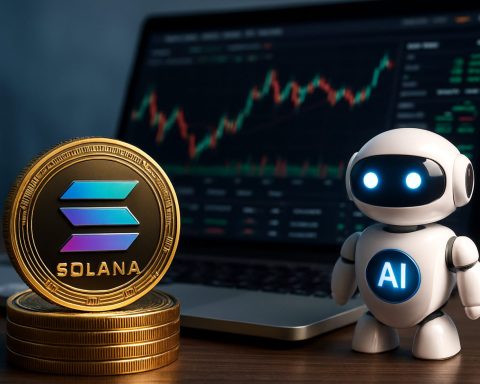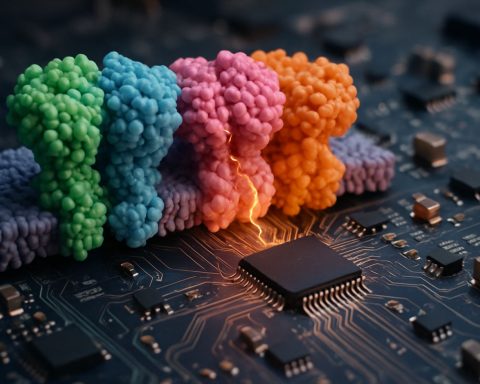Breaking Barriers in Quantum Computing
The realm of quantum computing is on the brink of a monumental shift, thanks to a groundbreaking advancement in error correction methods that could redefine the technology’s future potential. Researchers have successfully developed a cutting-edge technique enabling quantum systems to transition seamlessly between different error correction codes, thereby drastically enhancing computational precision and dependability.
Decrypting Quantum Challenges
Classical error correction methods fall short in a quantum framework due to the fundamental principle that quantum states cannot be directly copied. This poses unique challenges for maintaining data integrity during calculations. Taking inspiration from classical error correction, researchers have created sophisticated quantum codes by leveraging the entangled states of qubits, allowing for more efficient error detection and correction.
Pioneering Achievements
In a landmark achievement, researchers from the University of Innsbruck and RWTH Aachen have operated universal fault-tolerant quantum bits, marking a significant progression in quantum error correction techniques. This accomplishment lays the groundwork for further innovative strategies, such as those developed by Markus Müller’s team, who introduced a dynamic approach allowing systems to toggle between various error correction codes. This adaptability optimizes complex computational processes.
Future Impact and Industry Transformation
The implications of these advancements extend far beyond technical realms. With superior error correction, quantum computers are set to revolutionize industries by enabling unprecedented precision in areas like cryptography, pharmaceuticals, and environmental modeling. This transformation could lead to accelerated innovation and improved global strategies.
Balancing Act: Opportunities and Challenges
Opportunities: More reliable quantum computing facilitates scalability and broader applicability, especially in tackling complex scientific problems.
Challenges: The complexity of implementing dynamic error correction and the significant resources required could hinder widespread adoption.
Conclusion
As we stand on the precipice of mainstream quantum computing, the refinement of error correction techniques promises a transformative future, ushering in an era where technology’s potential is reimagined. Stay tuned for more groundbreaking updates in the field of quantum computing.
Revolutionizing the Future: Quantum Computing’s Environmental Potential
The promising advances in quantum computing, particularly in error correction methods, are poised to have profound effects on various global dimensions, notably the environment. Quantum computing’s enhanced precision and dependability equip it to tackle environmental issues with an unmatched level of sophistication, providing insights and solutions previously deemed unattainable with classical computational paradigms.
Computational Efficiency and Environmental Modeling
Quantum computing’s prowess lies in its ability to process vast amounts of data with exceptional speed and precision. In the realm of environmental science, this capacity means developing more accurate models of climate change, ecosystems, and weather patterns. Quantum computers can simulate complex atmospheric phenomena, providing crucial data for predicting weather extremes and long-term climate change impacts.
Accurate modeling of environmental systems is critical in formulating effective policies for climate mitigation and adaptation. Improved predictions lead to better preparedness, minimizing both human and ecological losses. By enabling more precise forecasts, quantum computing aids in resource optimization, ensuring that measures like water conservation, agricultural planning, and disaster response are efficiently executed, thereby reducing environmental degradation.
Reducing Energy Consumption
Traditional supercomputers consume vast amounts of energy to perform tasks that quantum computers can achieve more efficiently. By potentially replacing conventional data centers with quantum solutions, we could significantly reduce the energy footprint of global computing infrastructures. This not only lowers greenhouse gas emissions but also sets a precedent for sustainable technological development, aligning with global environmental goals.
The Future Interconnectedness of Humanity and Technology
As quantum computing becomes more integral to various sectors, its environmental impact could help mend the rift between technological advancement and ecological sustainability. The ability to solve previously insurmountable problems could usher in a new era of innovation that places ecological health at the forefront of global priorities.
Moreover, the implications for humanity extend far beyond environmental solutions. Quantum computing’s breakthrough in sectors such as pharmaceuticals could lead to the development of new treatments, promoting health and longevity. In cybersecurity, improved cryptographic techniques ensure safer digital interactions, enhancing data privacy and societal trust in technological systems.
Conclusion
Quantum computing represents a pivotal technological frontier, not only transforming industries but also promising a more harmonious relationship between human progress and environmental stewardship. As research continues to advance, these systems may very well define the future landscape of our planet, ensuring that as we innovate, we also preserve and sustain.
The Future of Quantum Computing: A Revolution in Error Correction
Quantum Computing Innovations: A Leap in Error Correction
Quantum computing is witnessing a dynamic evolution, with new breakthroughs in error correction heralding transformative changes in its potential and application. This cutting-edge development is set to redefine the landscape of quantum technologies, providing an unprecedented leap in computational accuracy and reliability.
Innovations in Error Correction Techniques
Recent advancements have introduced a novel methodology that empowers quantum systems to transition smoothly between different error correction codes. This innovative approach significantly enhances both the precision and dependability of quantum computations. By leveraging entangled qubit states, researchers have developed sophisticated quantum codes that ensure more efficient error detection and mitigation compared to traditional methods.
Market Impact and Potential Applications
Pros and Cons of Advanced Quantum Computing:
Pros:
– Enhanced Precision: The new error correction techniques enable highly accurate computations, crucial for sectors relying on complex data analysis.
– Industry Transformation: Sectors such as cryptography, pharmaceuticals, and environmental modeling are poised for revolutionary changes, leading to faster innovation and improved strategic planning.
Cons:
– Implementation Challenges: The sophisticated nature of dynamic error correction presents complexities that might slow down widespread adoption.
– Resource Intensive: The deployment of these advanced techniques demands substantial resources, potentially limiting immediate scalability.
Use Cases:
1. Cryptography: Enhanced error correction can lead to stronger encryption methods, essential for securing sensitive information.
2. Drug Discovery: More accurate quantum simulations can expedite the discovery of new medications by better understanding molecular interactions.
3. Climate Modeling: Improved computational precision assists in creating more reliable models crucial for predicting climate changes.
Emerging Trends and Future Predictions
Trends:
– Increased Investment: As the potential of quantum computing becomes more evident, investment in these innovative error correction technologies is expected to rise.
– Interdisciplinary Collaboration: Cross-industry partnerships will likely become more common as businesses seek to integrate quantum computing capabilities into their operations.
Future Predictions:
– Quantum Ubiquity: With ongoing advancements, quantum computing is anticipated to become a staple across various high-demand industries.
– Enhanced Security Protocols: The evolution of quantum error correction will lead to more sophisticated security measures, fundamental for safe digital operations in an increasingly connected world.
For more information on recent developments in quantum computing and associated technologies, explore resources from reputable domains such as IBM and Google.
Conclusion
The refinement of quantum error correction techniques marks a significant milestone in the journey towards mainstream quantum computing. As these developments continue to unfold, they promise an era where the boundaries of technology are consistently challenged and reimagined. Stay informed as we continue to follow the groundbreaking advancements in quantum computing.











